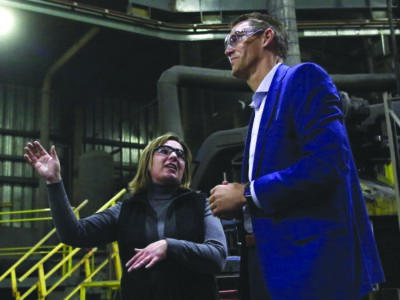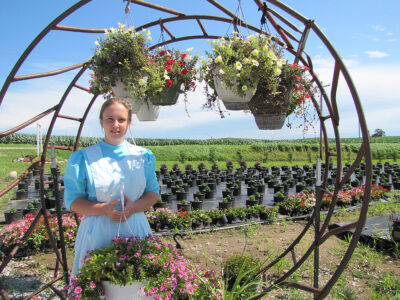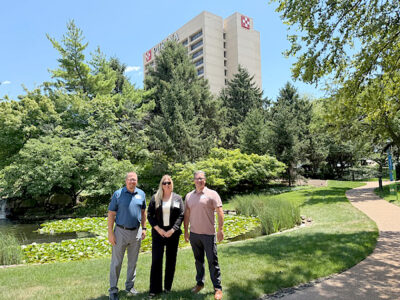Supercharging soil with algae
Farmers cut fertilizer, boost yield potential
-
-Submitted photo
Live algae is one of the most powerful, efficient biologicals a farmer can apply, according to Camille Newsom, director of grower support for EnSoil Algae.
-
-Submitted photo
EnSoil Algae harnesses the power of Chlorella vulgaris (Latin for “common green”) to build the soil biology bank. This ancient species of freshwater green algae is found almost everywhere around the globe — from Africa and Asia to areas covered with permafrost.
-
-Submitted photo
One Reinbeck-area farmer who used EnSoil Algae saw a 49% increase in corn yield in one trial. He also noticed that treated plants looked greener in a second trial.

-Submitted photo
Live algae is one of the most powerful, efficient biologicals a farmer can apply, according to Camille Newsom, director of grower support for EnSoil Algae.
Ever wonder how farmers like Russell Hedrick of North Carolina win national corn growing contests?
While there’s no silver bullet, Hedrick used a system of biological inputs and regenerative management practices to help him reach 459.1 bushels per acre in 2022 — a milestone many corn experts said was impossible.
His recipe for success included EnSoil Algae, a powerful, living green algae biostimulant. Live-cell green algae is one of the hottest new technologies that’s helping growers get more from their acres.
“It’s all about harnessing the power of life in your soil to drive production,” said Tucker Garrigan, director of sales and partner development for Enlightened Soil Corp., which supplies EnSoil Algae. “Algae has been around since life began on this planet, but we’re talking about it in a new way.”
EnSoil Algae is a live-cell algae that can be tank-mixed and sprayed, either on the soil or through foliar applications. It helps improve grain quality, test weight and yield potential by helping unlock free fertilizer that’s already in the soil.

-Submitted photo
EnSoil Algae harnesses the power of Chlorella vulgaris (Latin for “common green”) to build the soil biology bank. This ancient species of freshwater green algae is found almost everywhere around the globe — from Africa and Asia to areas covered with permafrost.
“This is where the economic opportunity is with algae,” said Garrigan, who noted that EnSoil Algae can help farmers reduce their commercial fertilizer by a third — or more. “It’s not uncommon for growers to cut their fertilizer by 50% or more.”
That’s a big deal as the cost of ag inputs continues to rise, profit margins shrink and farmers face pressures from all sides, Garrigan added.
EnSoil Algae harnesses the power of Chlorella vulgaris (Latin for “common green”) to build the soil biology bank. This ancient species of freshwater green algae is found almost everywhere around the globe, from Africa and Asia to areas covered with permafrost.
“This algae has evolved over millions of years, and it’s extremely durable,” Garrigan said.
Hedrick, who farms with regenerative ag practices, applied this live Chlorella vulgaris algae formulation three times during the growing season when he produced nearly 460 bushels of corn per acre. He recognized a significant contribution from the algae and continues to use it as a key component in his system today.

-Submitted photo
One Reinbeck-area farmer who used EnSoil Algae saw a 49% increase in corn yield in one trial. He also noticed that treated plants looked greener in a second trial.
“Live algae is one of the most powerful, efficient biologicals you can apply, and it plays well with others,” said Camille Newsom, director of grower support for EnSoil Algae.
EnSoil Algae works with humic acid and fulvic acid, as well as other biologicals, Garrigan added, “It’s 1 plus 1 equals 3, 4, and sometimes 5.”
Science reveals live algae’s super powers
If all this sounds too good to be true, look at the science. Dr. James White, a professor of plant pathology at Rutgers University, has spent the last decade advancing the work of a team of Australian microbiologists’ findings on plant and microbe interactions. They termed this process “rhizophagy.” This previously unknown symbiotic interaction is an interaction essential to nutrient cycling in the soil.
White has tested EnSoil Algae in multiple studies. Using high-powered microscopes, he observed algae filled with bacteria in the rhizosphere — the soil zone directly influenced by plant roots. The algae penetrated plant root hairs and then appeared to “explode,” releasing beneficial bacteria into the root hairs.
Since plants treated with EnSoil Algae had greater root length and mass, White postulated that beneficial bacteria that the living algae cells transported have a favorable effect on the host plant. The transport mechanism, attributed to live algae, is a novel finding.
Simply put, EnSoil Algae stimulates and grows the soil’s microbial population, along with the diversity of these helpful microorganisms. These microbes obtain nutrients (nitrogen and minerals) in the soil, and nutrients are extracted from microbes into the cells of plant roots to nourish the crop.
But there’s a catch. Over-applying nutrients (including synthetic nutrients) shuts down this natural cycle. “It makes the soil biology ‘lazy,'” Newsom said. “It’s important to give your soil biology a job.”
Think of this in terms of pizza.
“If you’re sitting on the couch and someone brings you a pizza, you’re probably going to eat it,” Newsom said. “But if no one brings you pizza, you’ll have to get up and make your own.”
When Chlorella vulgaris (the live algae in EnSoil Algae) are present, they release signaling hormones (phytochemicals) that tell other beneficial microorganisms in the soil to wake up and go to work. It’s essential to have living roots in the ground to feed carbon to the soil microbes to power this system, Newsom said.
“EnSoil Algae contributes to the photosynthetic capacity of the plants, because it has been shown to increase chlorophyll in the plants,” she added. “This puts more carbon in the soil to feed that population of microbes that’s now ‘awake’ and working.”
This works, no matter where you farm.
We’re seeing consistent results with EnSoil Algae, regardless of climate or soil type,” Garrigan said.
Making plants more resilient
Practical Farmers of Iowa (PFI) has conducted on-farm research into various biostimulant products, including EnSoil Algae. The studies were designed to determine whether biostimulant products 1) improve corn yield; 2) can possibly reduce nitrogen fertilizer rate; and 3) are cost-effective.
PFI worked with Reinbeck-area farmer Jack Boyer, who tested EnSoil Algae on some of his acres in 2024. Boyer performed two trials. He noted a significant (49%) increase in his corn yield in one trial with EnSoil Algae. He saw large increases in revenue from his EnSoil Algae-treated strips in trial 1, which outweighed the increased cost of the biostimulant.
Boyer saw no significant change in the other trial. Although the yield of the EnSoil Algae-treated strips were not significantly higher than the control in his second trial, Boyer remarked that the treated plants looked greener.
Dennis Klockenga, a certified crop adviser (CCA) and crop management consultant with ProfitProAG in Albert Lea, Minnesota, likes how EnSoil Algae fits well with ProfitProAG’s systems for regenerative ag and organic farming.
“Algae is a living plant without roots, stems or leaves, but it promotes biodiversity. This incredible technology improves soil function, promotes plant health, boosts yield potential and helps produce more nutrient-dense food.”
Keith Lovrien, who farms near Clarksville in northeast Iowa, tried EnSoil Algae in 2024, after hearing about the product at The Big Soil Health Event in Cedar Falls. He used a pull-behind sprayer to apply EnSoil Algae two different times, including pre-plant, and again around the V4 growth stage.
He created a system of check strips throughout his cornfields where he applied the algae. Throughout these acres, he sprayed the algae on 90 feet, and then left 60 feet with no algae application.
“We started the year in a D3 [extreme] drought,” noted Lovrien, who raises corn and soybeans. “By harvest, we were in a D2 [severe] drought. We saw a 40- to 50-bushel yield advantage where the algae was applied.”
He could see a difference during the growing season.
“By the time the corn tasseled, it was taller where the algae was applied,” said Lovrien, a no-tiller who uses cover crops. “That impressed me.”
Boosting plants’ resilience during tough environmental conditions is a big benefit, he added.
“The EnSoil Algae really helped the corn shine. The yield results probably wouldn’t be that dramatic in a non-drought situation.”
No matter the weather conditions, Lovrien appreciates how EnSoil Algae adds more beneficial biology to the soil.
“It’s a good product that definitely pays for itself.”






